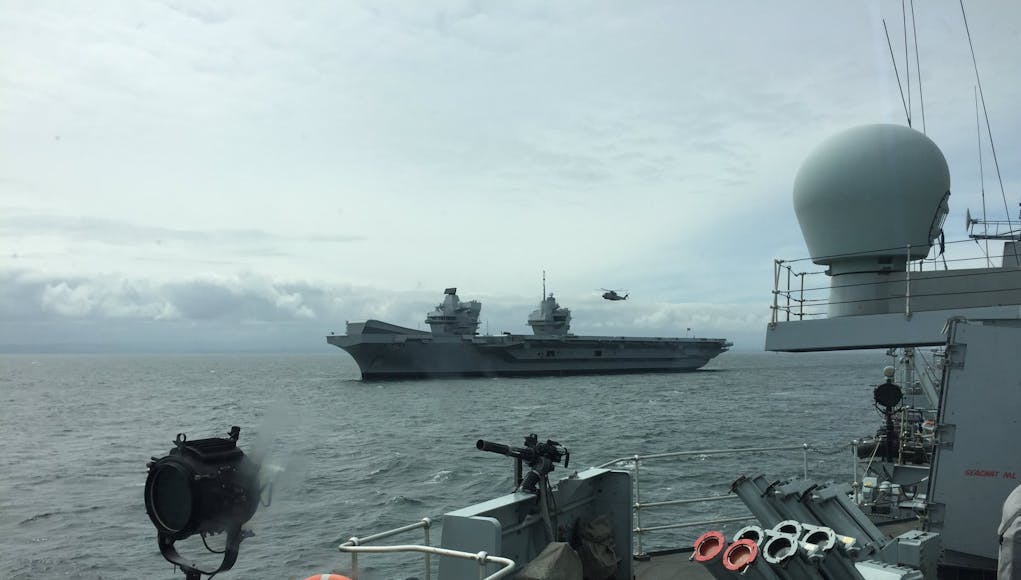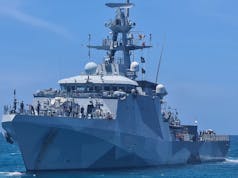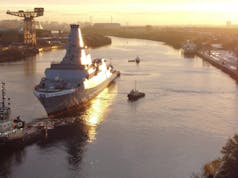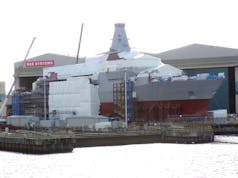Admiral Sir Philip Jones, First Sea Lord and Chief of Naval Staff, spoke at at the International Institute for Strategic Studies (IISS) in London on, alongside the US Chief of Naval Operations, Admiral John M Richardson.
The subject of the conference was: ‘What’s Past is Prologue: Global Navies and Security, Order and Prosperity’.
The transcript of the speech is displayed below.
As some of you will have heard a few weeks ago at the RUSI maritime conference, the Secretary of State for Defence spoke of his vision for the Royal Navy, delivered through the vehicle of the Sir Henry Leach memorial lecture, the first of those in a series; I was grateful to him for coming to do that. He reflected on how today’s Royal Navy would be viewed by that great post-war advocate for the value of sea power, Sir Henry Leach.
Of course, he held the office of First Sea Lord during the Falkland’s conflict, that formative experience of my own Naval career. Sir Henry’s understanding of navies and what they mean to an island nation like the UK was forged during his time as a Junior Officer in the Second World War.
But as many of you will know, at that stage it wasn’t Sir Henry who was making the headlines. It was his father, Captain John Leach, Captain of the battleship Prince of Wales, a King George V Class battleship. It had a short but very busy life, lost eventually in December 1941 off the coast of Malaya but with great significance earlier that year she had sailed across with Prime Minister Churchill to Placentia Bay, Newfoundland, in August 1941 to provide the venue for an historic meeting between Prime Minister Churchill and President Roosevelt, at which they set the scene for that pivotal policy statement that emerged from that meeting, the Atlantic Charter.
In those darkest of times at the height of the Second World War, our shared ideology of Anglo-American internationalism shone through, a clear expression of intent that Britain and America had to cooperate for the cause of international peace and security.
In the 77 years since that statement was issued, I would contend that the world has changed significantly, perhaps in some ways beyond all recognition.
Because today, as you heard from CNO, we live in an interconnected world where information is increasingly seen as the vital resource. Where we face an increasingly diverse range of potential adversaries, all of them emboldened by weapons proliferation. Where the resultant threats abound from space to sea bed.
It might seem rather alien to Captain John Leach on the bridge of Prince of Wales in 1941, or even to his son, Sir Henry on the bridge of the Royal Navy in 1982.
Yet there are also constants that I think would have been entirely familiar to both of them.
Crucially the importance of the maritime domain, the challenges of strategic great power competition, and the commitment of Great Britain and the United States to uphold international law and freedom of access to the global commons of the sea. All of those are common threads, as applicable in 2018 as they were in 1941.
So I’m indebted to Admiral Richardson for his very clear articulation of why the maritime matters in the 21st century, the brilliant slides he used to illustrate that, and why there is a collective security challenge that we face in that maritime domain. You won’t be surprised to hear I absolutely share that view. Indeed you could take that map of the world that he showed, and his Navy is of course deployed very extensively around it at scale to very significant effect. But so is the Royal Navy, of course to less scale but I hope also to significant effect. We’ve been operating in every ocean in the world and share the US Navy’s operational focus about the importance of presence. The importance of influence.
I was going to highlight just one area where we are linked, perhaps more than anywhere else, and it’s seen renewed efforts by both our Navies alongside our partners to counter the proliferation of threats; that’s in the North Atlantic. You only need look at the hugely significant symbolism of the United States Navy re-establishing the 2nd Fleet and the very fact that the Royal Navy’s high readiness response units in the North Atlantic are called upon ever more frequently.
It will be a major area of shared capability development as we look to how we will operate in that theatre going forward; equally importantly, the very high levels of operational activity now are shaping the thinking of both our Navies.
But our responsibilities, our shared responsibilities, are not of course confined to the North Atlantic. This year the Royal Navy has been out and about, perhaps at greater extent than for over 10 years. Operating, as I said, in every ocean of the world, trying to address the strategic challenges of today as seen from the United Kingdom, and part of a collective effort with all of our allies to maintain freedom and security on the high seas. And to enable that growth of global economic prosperity upon which our nation depends. And to uphold the international norms which we are the two principal nations and navies charged with defending.
There is of course nothing new in that. Historians and those who study the Royal Navy over a long period will know we’ve been at this for half a millennium, in some ways in an unchanged way. It’s all about national interest, it’s about exerting national influence, it’s about supporting partners and it’s about promoting our country’s prosperity; nothing changes in that space.
But to meet the breadth and depth of the security challenges we face today, and to have a sense of being able to deal with them going forward, we’re going to need a Navy that can bring a full spectrum of world-beating maritime capabilities to bear, alongside our partners, to deter and if necessary to defeat would-be aggressors who would challenge our nation. And we need to be able to do that on the waves, above and below them. We need to be able to do it from the sea to the land and we need to be able to do it in space and cyberspace. It’s quite a challenge to be able to do all of that at the same time.
And that’s exactly how the Royal Navy is adapting, transforming and modernising. And the current Modernising Defence Programme that’s running at the heart of Whitehall is enabling us to do that; the Navy is leaning powerfully into it as a great opportunity for us to realise that vision.
The arrival of our new aircraft carriers, Queen Elizabeth and Prince of Wales, along with their F35B lightning aircraft that will fly from them, means that we too will soon be able to take our place alongside the US Navy and French Navy delivering continuous carrier strike capability as part of a globally deployed maritime task group. That’s a very significant statement for the UK as a nation, not the Royal Navy as a navy, to make.
If you combine this with the fact that we have been delivering continuous at sea deterrence, unbroken for 49 years, and then you add into that our expertise in the littoral based upon the specialist capabilities vested in our Royal Marines and the very strong link they have with the US Marine Corps, and then you underpin all of that with a sustained piece of recapitalisation which we are undergoing across the whole fleet, across all our fighting arms, and the innovation we are reaching into along with our partners in the US Navy to embrace some of the new and emerging technologies that are racing into the maritime space, I think we can be confident that we’ve got a Royal Navy that is still very much at the vanguard of world Navies, fielding a potent suite of capabilities that few outside the United States can match.
But as much as the Royal Navy has to be able to do all of that, to retain the sovereign capability to act on its own when it needs to, even the most cursory analysis of our history as a nation will show that we are always better off when we work in partnerships.
NATO is of course the most obvious example of that, and I’m delighted to see that [Vice Admiral] Clive Johnstone [RN] is here today, to embody the maritime leadership within NATO that he provides on our behalf. That alliance has for so long been the cornerstone of both our national defence and that of all our allies who are a part of NATO.
And you only need look at the work of other key alliances too, like the Combined Maritime Force coalition in the Middle East, led by the United States with the Royal Navy as deputy, to see how that has contributed to regional security in a way that has enhanced collaboration with regional and international partners in a part of the world that is absolutely vital to the country’s economic and energy interests, but perhaps more unstable than it’s been for a long time.
Like the US, Britain has partners both old and new right around the globe.
Closer to home in Europe, our bi-lateral agreement with France, articulated initially at the Lancaster House agreement in 2010 and re-affirmed at the Sandhurst conference in January this year has seen us form a Combined Joint Expeditionary Force with the French. And we showcased that with exercises off the Brittany coast only last month, which I attended. It’s a very credible and capable force, fully integrated with Royal Navy and Marine Nationale Units. So too do some of the older but well established, credible links that we have with the likes of the Royal Netherlands Navy promote excellence in our combined amphibious warfare capabilities.
In the same vein, we are looking to establish those partnerships further afield. You’ve heard CNO talk about the significance of our new tri-lateral arrangements between our two navies and the Japanese Maritime Self Defence Force. That’s not a meaningless piece of showmanship, where geography makes it impossible to do something real. It’s credible, it has significant workstreams that are driving forward, and we’ll be meeting again in Japan towards the end of the year to cement our plans.
But with all of these alliances, be they bi-lateral, tri-lateral or larger, multilateral ones, I think they point to what must be in place and that’s interoperability. Not just interoperability based on equipment, the ability for our comms systems to talk to each other, but also interoperability based on a clear understanding of how each other works, how each other thinks, and how each other fights.
Understanding each other’s capabilities, their limitations as well as what they can do. Understanding each other’s tactics and procedures and how to best fold them into each other. Understanding the nuances around how we each interpret rules of engagement, how we employ doctrine. All of this is essential if we’re going to have a chance of delivering together from Day 1.
UK/US Relationship And yet as much as all of these alliances and partnerships are highly valued by the UK, I will eventually boil down to complete agreement with Admiral Richardson that the key one is our link as a Navy to the United States Navy. There is something unique about that, something unique about the strategic nature of our partnership that goes back a long way.
Many of our Admirals and senior Civil Servants are over in Washington this week commemorating the 60th anniversary of the MDA, a hugely significant moment in the way we work together in the nuclear and submarine field.
The UK is the only Tier 1 partner in the F35 programme and from the earliest days of this programme, Royal Air Force and Fleet Air Arm pilots, ground crew and engineers have been working side by side with their US Navy and US Marine Corps colleagues to ensure that, as much as our new aircraft carriers will sit at the heart of the UK’s Joint expeditionary force, so too will they be ready to work with our American counterparts from the off. And you’ll see us doing that in 2021 when we first deploy that carrier operationally.
And as we look at the increasingly challenging underwater battlespace that I alluded to earlier, Britain and the US will be working very closely together to develop some of the world’s most advanced under-sea technology, including of course collaboration with the deterrent submarine programme.
It couldn’t be a closer link.
I will wrap this up now and I know we collectively look forward to hearing your questions. But I just leave you with this thought. Our Defence Secretary called upon the Royal Navy to lead from the front, to exploit our unique ability to exert not just soft power across the globe as we’re doing at the moment but also to be able to back it up with tangible hard power.
That’s a call that is a challenging one to achieve; for the service to do both, credibly, at the same time. It takes a lot of application and effort. But it’s a challenge I readily accept, because that enables the Royal Navy to power on, to get the fleet it needs to fulfil its commitments and meet the broad range of challenges we face both at home and around the world.
And as we look to fulfil our centuries-old role on behalf of our nation, we do so safe in the knowledge that wherever we are in the world, we can find partners and allies to work with. And we will find no partner more valuable, more credible, more trusted, than the United States Navy. And I’m honoured to think that they regard us also as the partner of choice.
Thank you.














Significant statement-look what idiots we are.
whoever rites the speeches for the navy p.r department, it would be nice to hear a few different words. than the blah,blah
Four Wasp-Class (Type) would have suited Britains needs more than the QE class.
would never happen a couple of mistrals would need half the crews and be more efficient.
I believe they only carry 6 F-35B’s each though? Not sure what the max. surge level would be but I’d hazard a guess at less than 2 QE’s. Also sortie generation rates would be far lower meaning less potential flights per unit of time.
They are also a completely different type of vessel, being able to launch landing craft etc.
WASP can handle between 16-20 F35B.
Interesting, my info was way wrong haha. I wonder how that changes with shore assault loads, can they max out on both??
I know they can carry up to 2,000 fully kitted USM.
Not sure if they max out on troops they can max out on vehicles or Aircraft too.
I would assume not, prob a blend of them all in surge times.
Be an interesting question to ask a serving or former Navy person.
Too much emphasis being put on the carriers, by doing this it could used to cut other capabilities. Senior figures should just be say its the long overdue return of capability we lost when the Audacious class was decommissioned.
Expat- I thnk what the navy was hoping for was to get the carriers built and delivered and then the government would surely provide the warships and sub numbers needed to protect them and deliver a carrier battle group right?
Well…. that would be the sensible way around the issue and ensure the royal navy had the force level needed for carrier strike to be delivered, only no one expected to get St Teresa May. Daughter of a clergy man is always going to be a slightly dodgy individual to have as PM. Very weak on defence.
Asked outright do you believe the UK should remain a tier 1 military power, no answer.
says it all really… dereliction of 1st duty of a government ensuring the defence of the realm
Totally agree….. but the current leader of the opposition would be far worse off defence. No votes in defence until we actually need to defend ourselves, then its all too late.
“I once ran through a field of wheat” – Theresa ‘edgy risk taker’ May.
At least Williamson has her ear and is making some head way. If he keeps pushing the way he has been, we’ll get what we need eventually.
Forget the Govt and the Civil Service mandarins, It was the fun loving ( throw your car keys in the bowl) Adm West who caused much of the current issues. He sacrificed the FF/DD fleet on the alter of carrier strike. He was a useless as 1st Sea Lord.
If looked t in the long term though, carrier strike is far too complex to regenerate at will as the geo graphical situ changes. Whereas increasing the frigate programme is always possible if geopolitics situation continues to slide. Looking at the platforms which most deter and have most impact on an adversary, carrier strike is up there with ssbn/SSN. It’s also a big force multiplier working with escort heavy allies, making RN a sort after partner. They can also multi role in much more common low threat environments like stabilisation and humanitarian support. A few additional destroyers, frigates and SSN only add up to a token presence or unnecessary additional land attack missile capacity. It is the ability to influence events ashore that is more crucial in most circumstances.
He did, but he was promised CEC and a few other toys in compensation as force multipliers and then Treasury reneged on the deal. Not defending him, just saying…
T31 has the potential to be a game changer. Make no mistake the Huitfeldt class are great ships and good enough to be one of those escorts you talk about from an ally, but we still seem unhappy with it for some reason for our own navy.
Let’s get on with Arrowhead and lets commit to our future fleet of 13 T26 and 25 T31. How we configure them is down to us, lets be innovative and lets be proactive.
I like this FSL – he is a moderniser and doing well, just need more people to do everything and better pay and conditions.
38 frigates. What exactly would we do with them?
All great having two big carriers won’t have a enough aircraft to equip them for years never mind enough escort ships who’s clever idea what’s not to give them adequate self defence weapons think none of this matters really how long before one or both get sold at knock down price to the likes of Brazil
2/6 type 45s and 3/8 type 26s and 1/⅞ astute will be enough routinely. As will 22 f35s, with a us marine contingent on top. NATO allies have plenty of escorts to flesh this out further. A best effort from UK in high threat environment would see us being able to do this alone for a short timeframe but very unlikely to be required given the strength of our alliances and bilateral defence agreements.
12 not 22.
Pac-Man – 38 frigates and destroyers is a pipe-dream.
All the recent speeches at RUSI and the IISS have focused on the evolving role of the armed forces. Speeches are long on words and short on substance for we already understand cyber-warfare, terrorism, carrier strike and don’t need the context explained. To be fair, our Generals and Admirals call for greater resources for defence but they don’t adequately explain the scale and dynamics of the emerging threat to NATO. Perhaps, they don’t realize it themselves?
The politicians, meanwhile, refuse to speak about anything other than the percentage of GDP allocated to defence or whether we have a commitment to being “Tier 1” when we haven’t been “Tier 1” since the 1950s.
Given a threat environment where the U.S. must focus on the Pacific to counter massive Chinese militarization and declared expansionist intentions, Britain must do more to protect itself from an increasingly credible Russian threat. Our frigates are about to be retired with no ready replacements. There is a manpower shortage that stretches the Navy thin in peacetime and would probably defeat it in wartime. We have 227 main battle tanks! None of our politicians seem to have done anything to understand “the first duty of the realm” in terms of threat analysis or context. I’m sure that they don’t research the subject for themselves. They don’t understand the game-changing evolution of Russian anti-ship missiles and they don’t want to imagine a conflict between China and the US. For such an event would reveal the unpleasant truth that they have been playing politics with defence for too late long and failed in their “first duty”.
I can understand China and the US but what is the Russian threat? If it’s a threat then it must be a threat of something, all I keep hearing is “Russian threat”
So what is Russia with an economy smaller than Italy’s, what is their threat to us.
SS they are standing up their submarine force again and while I can’t vouch for the standard of the crews or level of training, the kit is not bad
Hi Nick
I dont agree with it being a pipe dream, it is very doable, as it averages out around £1bn p.a. Over 25 years – we just need to decide what we want and how to do it.
I think we have plenty of work for 38 combat ships (dont want to get hung up on specific ship types) and the standardisation of the fleet onto fewer more capable hull types would save costs.
Given we now seem to want to be more global as a navy – I think we need these vessels and as many people on this forum keep telling me – steel and air are cheap.
There are downsides of course, but its how we choose to spend our limited resources that needs addressing fewer platforms in larger volumes with more stable supply chains and a chance of export sales is my preferred stance.
It should also be noted these new ships operate with a crew of circa 120 – so are far more efficient than previous large ships and the age of the UMV is upon us and these ships will essentially become mother ships for a range of capabilities.
Overkill for fisheries – yes, but we should cycle our older vessels into this role in their last 5 years of life anyway, rather than having a small fleet of dedicated ships. Build new and manage their lifecycle accordingly. When they are older – dont have expensive refits – move them into less rigorous roles or sell them off.
It might help your case if you spelled out ship types so people can follow your thoughts. For example:
6x Type 45 -> 6x Type 26 AAW
8x Type 26 ASW
5x Type 31 GP
13x MCM -> 13x Type 31
5x OPV -> 5x Type 31
This totals 37 frigates/destroyers (14x Type 26 + 23x Type 31) with a similar total hull count to today. The MCM function becomes UUV/USV mission module based and capable of deployment from everyone of the vessels, from RFA vessels and from the shore. Some Type 31’s might be built to be more quiet (since the base IH/Arrowhead 140 design supports this) for additional ASW-lite support.
The problem is that the carriers can without a doubt set a statement, the problem is a carrier with 12 jets on it and one or two escorts, sets the wrong message, it says that the Royal Navy is stretched beyond its capabilities.
When you see pictures of the US carrier battlegroup, it oozes power, simply because you can see dozens of planes lining the decks and a massive escort.
Hopefully the government will increase the current planned active numbers of f35b, to enable the carriers to be normally loaded with 30 odd jets, which would be an amazing floating sign of power.
Very true and you paint some powerful visual images in my mind, including sadly the rather sorry image of a 12 F-35B embarked air wing and a couple of frigates escorting but the fact is we will never have anything remotely close to the USA’s military resources and this is, in my opinion, another area where it would be dangerous to expect too much. We should certainly aspire to do better than that “sorry image” that you managed to paint in my head but we’ll never field the equivalent of a US CBG.
Off the back of your post I was looking at CdG carrier photos and CBG. I found an interesting page with an infographic (in French) of a CdG battle group. It lists 24 Rafele, 2 Hawkeye & 6 helos embarked with an escort group comprising 1 supply ship, 1 ASW frigate, 2 AAW frigates and 1 SSN all supplied by France plus 1 additional German ASW frigate and 1 additional US destroyer.
When our CBG is in a full-on power-projection role then 24 F-35B plus accompanying helos + 1 x Astute + 1/2 supply ship(s) (just FSS with Tide rendezvous as necessary or Tide + FSS permanently in the group?) + 2 x AAW frigates/destroyers + 2 x ASW frigates/destroyers + 1 extra frigate/destroyer to match the French configuration (possibly with 1, 2 or even 3 of the frigates/destroyers supplied by allies on most deployments) seems a reasonable goal to aim for and should be achievable. The UK should even be able to field that on its own in extremis (2 x T45 + 3 x T23/T26/T31) but if allies contribute some of the frigate/destroyer escorts then maybe it could be done without gutting most other current RN deployments to scrape together the escorts required.
I don’t think we’re that far away from being able to do something credible.
Here’s the link to the CdG article…
http://www.navyrecognition.com/index.php/news/defence-news/2016/october-2016-navy-naval-forces-defense-industry-technology-maritime-security-global-news/4527-french-navy-charles-de-gaulle-carrier-strike-group-mission-extended-until-mid-december.html
Sorry – that’s 4 helos embarked on the CdG not 6. The total CBG helo count is 8 – 4 on CDG, 2 on the French ASW frigate, 1 on one of the the French AAW frigates and one on the German ASW frigate. Rather surprisingly (to me) it doesn’t show the US destroyer as having a helo embarked.
That’s cause it’s a flight-1 AB which means no hangar, only flight deck
Excuses, excuses 🙂
But seriously – thanks for the info & for clearing up my confusion.
Doubtless a picture with lots of jets would be nice and may arrive in due course but I suspect anyone we might wish to influence with a carrier force is well capable of understanding the ship can carry up to 36x 5th generation strike aircraft if necessary along with various helicopters, without having to see them all on the deck. Definitely not worth sailing around with 30x onboard just for show.
Perhaps at some point, in conjunction with USMC, one of the carriers will exercise with a full load out of aircraft and you’ll get your picture 🙂
[…] New supercarriers and their F-35 jets ‘a very significant statement for the UK to make’ … […]
I notice in all these posts no one has mentioned that the F35b is a shared asset with the RAF and we all know what happened when the navy’s harriers where handed over to the RAF they could not wait to get rid of the sea harriers and then constantly made it near impossible for the navy to use the remaining harriers , even though they where useless to the navy as they where config as ground attack.
Geoff Hoon Gordon Brown and Lord West are guilty of wasting so far £15 billion of taxpayers money on the QeC and F35B and Hammond and Osbourne compounded it by there slash and burn of the surface fleet and Osbourne accounting tricks of putting MI6/MI5/GCHQ pension and the deterrent replacement cost into the defence budget adding £8billion in costs but freezing the defence budget . If you remove those items we spend 1.6% of GDP on defence not enough to fund a blue water navy.
Remember that the navy wanted cats and traps and the f18 the raf wanted f35a and the treasury said share f35b to save money, just remember Gordon Brown’s boast of ending boom and bust.